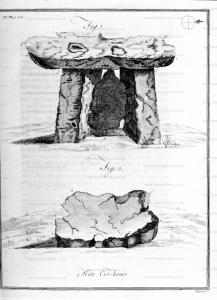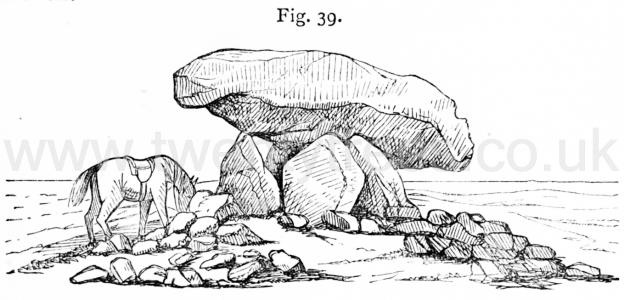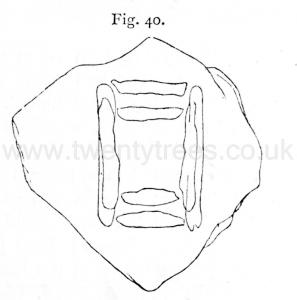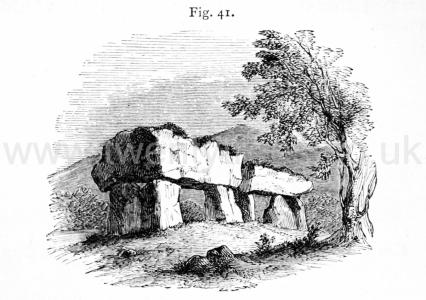Europe, British Isles, South-East England, Kent, Blue Bell Hill
Blue Bell Hill, Kent is in Kent.
Europe, British Isles, South-East England, Kent, Blue Bell Hill, Coffin Stone [Map]
Coffin Stone is also in South England East Standing Stones.
Coffin Stone [Map], also known as the Coffin and the Table Stone, is a possible Chambered Tombs of which only one large sarsen remains.
Europe, British Isles, South-East England, Kent, Blue Bell Hill, Kit's Coty House [Map]
Kit's Coty House is also in South England East Chambered Tombs.
Around 4000BC. Kit's Coty House [Map] was a Chambered Tomb constructed around 4000BC.
Perambulation of Kent Chapter Page 368. But the want of that one man, both quailed the courage of the Britons, gave newe matter of stomackc to the Saxons to repaire their forces, and brought upon this Realme an alteration of the whole Estate and Government. The Britons neverthelesse in the meane space followed their victorie (as I saide) and returning from the chase, erected to the memorie of Categerne (as I suppose) that monument of foure huge and hard stones, which are yet standing in this parish, pitched upright in the ground, covered after the manner of Stonage (that famous Sepulchre of the Britons upon Salisburie plaine) and now tearmed of the common people heere Citscotehouse [Map]. For I cannot so as suspect, that this should be that, which Beda and the others (of whom I spake in Chetham before) do assigne to be the Tombe of Horsa, which also was there slaine at the same time: partly bicause this fashion of monument was peculiar to the Britons, of which nation Categerne was, but chieflie for that the memorie of Horsa was by all likelyhoodleft at Horsted, a place not farre off, and both then and yet so called of his name, as I have already tolde you.
Archaeologia Volume 2 Section XVII. An Account of the Monument [Kit's Coty House [Map]] commonly ascribed to Catigern. By Mr. Colebrooke. Read at the Society of Antiquaries, June 12, 1766.

Archaeologia Volume 4 Section VIII. Observations on Kit’s Cotty House [Map], in Kent. In a Letter to the Honourable Daines Barrington (age 56), from the Reverend Mr Pegge (age 69). Read at the Society of Antiquaries, Jan. 13, 1774.
Archaeologia Volume 11 Section IV. Observations on Kits Coity House [Map], in Kent. In a Letter to Samuel Foart Simmons, M. D . F. R. and A. SS. By William Boys, Esq . F. A. S. Read Feb. 9, 1792.
Llewellynn Jewitt 1870. Kits Cotty House [Map], in Kent; the Chun [Map] cromlech, in Cornwall (figs. 39 and 40) the covering stone of which is calculated to weigh twenty tons; the Molfra [Map] cromlech, in the same county, which consists of a compact cist closed on three sides and open on the fourth; the Zenor [Map] cromlech; the Plas-Newydd cromlech, and many others which it is not necessary to enumerate, are all of the same class. The Plas Newydd (fig. 41) is a double cromlech, the two chambers being close together, end to end. The capstone of the largest, which is about twelve feet in length by ten feet in breadth, originally rested on seven stones, two of which have disappeared. The two erections undoubtedly were originally covered with a single mound.



Archaeologia Volume 14 Section XXXI. A Jew likewise got possession of those coins, and retailed them round the country for about a penny each, though mostly in a high state of preservation. If this urn had been found in Dr. Borlase's time, as it lay within three quarters of a mile of Castle Chûn, between which two spots there are many walls of a construction similar to that under which the coins were dug up, it would probably have changed his opinion respecting the builders of that fortification, which he supposes to be of Danish erection; and indeed he seemed to have some doubts on this subject, for he says, page 316, "Some of our round intrenchments on the tops of round hills in Cornwall may be Roman works, if either ways pass near or through them, or coins be found in them." It is difficult to conceive why the Doctor did not determine Castle Chûn to be a Roman fortification; for, in his describing an intrenchment in the parish of St. Agnes, he says, page 314, that it was formed with "too much art and military science for either Britons, Saxons, or Danes; "and yet, in speaking of Castle Chân, which he pronounces to be Danish, he says, page 347, "The whole of this work, the neatness and regularity of the walls, providing such security for their entrance, flanking and dividing their fosse, shews a military knowledge superior to that of any other works of this kind which I have seen in Cornwall." If this Castle Chûn was a station of the Romans, which seems extremely probable, it was also, anterior to their settlement there, a favourite hill of the Druids, if they were, as is generally supposed, the builders of cromlechs; for about 500 yards from the castle there is one on the north side; at little more than a mile further there are two on the eastern s; and two more in the north-east, distant four miles and three quarters. These cromlêhs, except one lately found, have been well described and delineated by the learned and accurate Dr. Borlase; but the great desideratum he lived not to see, is e. a human body interred under one of those erections, which has been recently discovered in the parish of Madron, and within half mile of the famous Lanyon Cromlêh, vulgarly called the Giant's Quoit. This Cromleh was found a few years since by the following incident. The gentleman who owns the estate of Lanyon, happening to be overtaken by a shower of rain in walking through his fields, took shelter behind a bank of earth and stones, and remarking that the earth was rich he thought it might be useful for a compost. Accordingly he sent his servants soon after to carry it off, when, having removed near a hundred cart-loads, they observed the supporters of a cromlêh, from which the cover stone was slipped off on the south side, but still leaning against them. These supporters include a rectangular space open only at the north end, their dimensions being of a very extraordinary size, viz. that forming the eastern side being ten feet and a half long, that on the west nine feet, with a small one added to complete the length of the other side, and the stone shutting up the south end about five feet wide. The cover-stone is about thirteen feet and a half, by ten feet and a half; but its length, and the height of the supporters, cannot be exactly ascertained, as they are inserted in the ground, the present height being about five feet. This cromlech is dissimilar to all others found in this county, which have small supporters, and the area under the cover-stone open on all sides; whereas this, when the cover was on, was fhut quite close at the top and on three sides, having only the entrance at the north end open, and therefore appears to resemble Kitts Cotty House [Map] in Kent, though the dimensions of this are larger. As soon as the gentleman observed it to be a cromlêh, he ordered his men to dig under it, where they soon found a broken urn with many ashes, and going deeper they took up about half of a skull, the thigh bones, and most of the other bones of a human body, lying in a promiscuous state, and in such a disordered manner as fully proved that the grave had been opened before; and this is the more certain, because the flat stones which formed the grave, or what Dr. Borlase calls the Kist-Vaen, i.e. stone chest, and a flat stone about fix feet long, which probably lay at the bottom, had all been removed out of their places. The scull, and some other bones, were carried into the gentleman's house, and shewn to his friends as curiosities, but were afterwards re-interred in the same spot inclosed in a box. These bones I have been assured were above the size of those of the present race of men, but I was not so fortunate as to hear of this event in time to get a sight of them.
Celtic, Druidical and Roman Remains. It is generally supposed that cromlechs were erected by the Ancients for the purpose of distinguishing the burial-places of their chiefs, or of other celebrated individuals. Paulinus and Agricola, in their several descents on the island of Anglesea, found Druidical circles and cromlechs there; and this mode of burial continued to be practised for some time after. We find that when Vortimer defeated Hengist and Horsa at Aylesford, in Kent, where both Horsa, and Catigern the British chief, perished, the fine cromlech, now called "Kit's Cotty House [Map]," was erected over the remains of the latter by his sorrowful countrymen. They may also have been used by the Druids for religious purposes; as similar structures are at the present time in India. For an account of these, we are indebted to W. J. Henwood, Esq., F.R.S., F.G.S., &c. After noticing the rock-basins, &c, which he observed there, he thus speaks of the cromlechs: — "In front of one of the Temples are two small cromlechs of slate: the larger is an oblong square, about 5 feet in length and 2½ feet in breadth, and is supported at a height of rather less than 3 feet, horizontally, on six stones; the smaller is triangular, and is perhaps 2½ feet wide; but instead of being flat it is supported at an angle of about 30 degrees from the horizon, in such a manner, that one corner is the lowest part, and one edge — the highest — is level; the props being applied to the inclined sides only, shelter the interior for about two-thirds of its circumference, but leave the rest open. The flat-topped cromlechs are used in differently as altars or as seats: for I have observed rice and flowers, as offerings, often laid on them; and just as frequently I have seen the natives sitting and resting their burdens on them: the inclined ones are employed only as receptacles for small rudely-made iron lamps, which are always lighted when religious rites are being solemnized. Level-topped cromlechs are frequently found alone; but I do not recollect an instance, amongst the scores I have seen, of an inclined one without a flat one in its neighbourhood."1
Note 1. Proceedings of the Royal Institution of Cornwall, 1855.
Europe, British Isles, South-East England, Kent, Blue Bell Hill, Little Kit's Coty House [Map]
Little Kit's Coty House, Kent is also in South England East Chambered Tombs.
Around 4000BC. Little Kit's Coty House, Kent [Map] was a Chambered Tomb constructed around 4000BC.
Europe, British Isles, South-East England, Kent, Blue Bell Hill, Smythe's Megalith [Map]
Around 3500BC. Smythe's Megalith [Map] was a Chambered Tomb constructed around the middle of the 4th Millenium BC, discovered in 1822 at which time it was dismantled.
Europe, British Isles, South-East England, Kent, Blue Bell Hill, White Horse Stone [Map]
White Horse Stone is also in South England East Standing Stones.
White Horse Stone [Map]. Previously two sarsen megaliths now only one remains. Possibly the remains of Chambered Tombs.